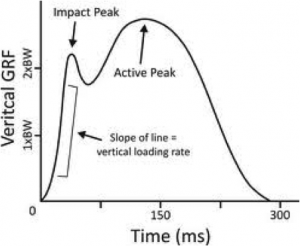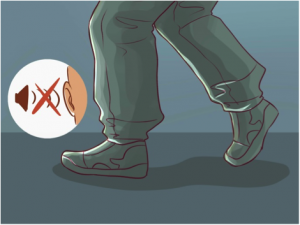Shock – Injury – Cadence – Quiet

How hard a walker or runner impacts the ground can be described with several biomechanical terms, including vertical impact loading rate, braking impulse force, and shock.
Scientists have determined it is not the magnitude of force, but the rate at which the force is transmitted from the ground to the foot and leg that is the critical factor related to the development of repetitive use injuries. The magnitude of the force is a function of how much you weigh. The issue is not whether you weigh a lot or weigh very little, but how quickly your body weight strikes the ground. In the graph below the less time it takes to reach the impact peak the greater the magnitude of the rate of impact loading.

Some walkers and runners have larger impact forces, and research is showing they are at increased risk for developing stress fractures and tendon injuries. The way an individual walk or run is thought to explain why some individuals have larger vertical impact loading rates.
Until recently research correlating large rate of impact loading with development of injuries focused on runners who were already injured. However, a 2016 publication by Irene Davis, a physical therapist at Spaulding National Running Center, reported on a prospective study of 249 runners – some who had never been injured and others who had a history of previous injury. Irene found that runners who land “hard” have higher rate of impact loading and an increased risk of injuries. Runners who have never been injured land softly, and had the lowest rate of impact loading.
Years ago, when I was running in local marathons, there was a runner who raced the same pace as mine. He was a noisy runner, and the loud sound of his feet striking the ground was irritating. I would try to speed up to get away from the annoying stomping, and he would speed up and keep pace with me. I never actually spoke with the stomping runner, so I don’t know if he had stress fractures, but the manner in which he ran led me to think he was someone who ran with higher rate of impact loading. At the time I thought it was odd – this stomping runner must have been 60 pounds lighter than me. Now I can recognize it is not how heavy you are, but how sudden or quickly your foot strikes the ground that makes the sound and impact.
Around the same time, when I was at about mile 20 in the New York Marathon, Grete Waitz came running by me and it felt like she was a “whispering jet” quietly blowing by me. I didn’t hear her approach; I just felt the breeze as she blew by me. She went on to win the women’s division of the marathon in record time. I would think Waitz has very low rate of impact loading when running.
How do you determine whether you walk or run with a relatively high rate of impact loading? The standard method of measuring shock requires a sophisticated three-dimensional motion analysis lab with force plates imbedded in the ground or treadmill.
During the past few years, with the advancement of wearable wireless tri-axial accelerometers, indirect measurement of shock when walking and running has become available. There are now smart phone applications that function like a tri-axial accelerometer. “There is an app for that”.
There is a growing body of evidence showing that, with training, people can alter the way they walk and run. Chris Napier of the University of British Columbia reviewed 27 studies and concluded the most effective way for “gait training” involved real-time visual and/or audio feedback.
The complex movement of running and walking involves multiple factors. There are likely multiple options available to change the way you run and walk. Basically they boil down to two effective methods – cadence training and quiet running.
When walking, the foot is in contact with the ground for less than a half second. When running, the foot contacts the ground for much less than a half second. Running at a fast 10 k pace the foot is contact with the ground for 0.028 seconds. The impact phase occurs in the first 20 percent of the time the foot is in contact with the ground. Therefore there is very little time – milliseconds – available to spread the impact forces to lessen the shock transmitted to the feet and legs.
One strategy of gait training to decrease shock is cadence training. Bryan Heiderscheit, a physical therapist at the University of Wisconsin, has shown that for a given speed a conscious effort to take shorter steps and more steps per minute results in a reduction of rate of impact loading. If the speed of walking or running is held constant and the individual uses the auditory feedback of the sound from a metronome to increase the preferred cadence for a particular speed to a relatively faster cadence by a factor of 5 percent, this effectively shortens the stride or step length. If the stride length is shortened, this results in a decrease in rate of impact loading. Some runners look like they are bobbing up and down or hopping down the road, and this manner of running results in a relatively higher rate of impact loading. A verbal cue to dampen your up-and-down motion can decrease the impact loading rate. An alternative verbal cue is to take short steps and more steps per minute.
Investigators at East Carolina University have taken this concept to the real world on the road. Using wearable accelerometers to provide real-time cadence feedback resulted in significant decreases in impact forces at the knee.
An alternative strategy to cadence training is listening to the sound of the foot striking the ground. Research done by young Australian physiotherapist Kevin Wernli when he was studying at Curtin University has shown that the sound of foot impacting ground is directly related to the rate of impact loading. The louder the sound of the foot striking the ground the higher the shock is.
I describe this strategy as a poor man’s force plate or accelerometer. Listen to the sound that your foot makes when hitting the treadmill or road and then try to land more quietly. Your risk of injury will decrease. This is another argument against running with head phones of ear phones. The cueing description I use now is, “Run like you are trying to sneak up on someone.” Run soft and quiet.
As a routine, now when I do a slow motion video analysis of walking or running form, I listen to the sound of feet striking the surface. When a repetitive use injury is on one side of the body, often there is an asymmetrical foot strike sound. One foot makes a louder sound. Using Wernli’s work we can assume one side of the body is experiencing more shock than the other.
Hearing asymmetrical sound of foot strike is an important clue when it comes to solving repetitive use injuries which are on only one side of the body. Hearing asymmetrical sound of foot strike is not the answer, to what is wrong. The side with the louder sound could be the injured weaker side, or it could be the uninjured stronger side. Currently there is no easy rule to determine the treatment. It requires a clinical problem-solving approach to determine whether the cueing should be to make the quieter foot strike louder, or to make the louder foot strike quieter, or both.
Walk and run close to the ground, crouched position, engaging muscles in feet and legs as you move. This decreased impact as you contact ground enabling you to move more quietly. Distribute weight through foot avoid accentuate heel strike.

Take shorter steps, more steps per minute, be quiet
Damien Howell Physical Therapy – 804-647-9499 – Fax: 866-879-8591 At-Home, At Office, At Fitness Facility – I come to you, I do home visits Damien@damienhowellpt.com
